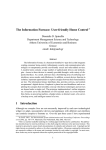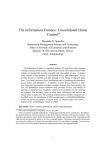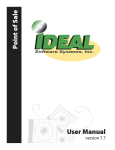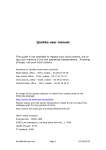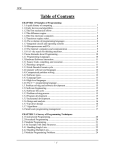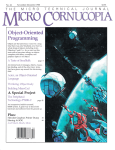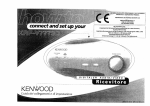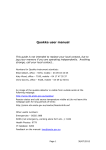Download Examiners` report on 2008 Tertiary Entrance Examination in
Transcript
Examiners’ report on 2008 Tertiary Entrance Examination in Information Systems Year Number who sat Number of absentees Non-examination candidates 2008 572 73 57 2007 636 102 46 2006 614 124 28 The examiners’ report is written to comment on matters relating to the Tertiary Entrance Examination in this subject. The opinions and recommendations expressed in this report are not necessarily representative of or endorsed by the Curriculum Council. The marking key provided at the end of this report was prepared for markers and may have been substantially amplified by discussions held in the pre-marking meeting. It is not intended as a set of model answers, and is not exhaustive as regards alternative answers. Some of the answers are less than perfect, but represent a standard of response that the examiners deemed sufficient to earn full marks. Teachers who use this guide should do so with its original purpose in mind. Summary The 2008 Information System paper was similar in structure to the 2007 paper. The general consensus among teachers was that the paper was set at an appropriate level of difficulty and gave students enough opportunity to achieve marks that would accurately reflect their ability. As with previous years the maximum possible marks were awarded for each question throughout the entire paper, indicating that full marks were achievable by capable candidates even for the most difficult questions in the paper. The examination panel attempted to create questions that required students to demonstrate their understanding of the material, rather than just regurgitation of learned definitions. Generally students’ performance varied in all content areas. There was no one area in which most students performed better or worse, rather the variation was amongst students. Some students performed well and others did not. As in previous years, students performed better in knowledge questions than in process and synthesis and evaluation questions. General Comments The examination consisted of fifteen multiple-choice questions (15%), twelve short-answer questions (25%) and twelve extended questions (60%). Candidates were not given any choice in the paper. The examiners attempted to ask questions that enabled candidates to demonstrate knowledge, process, synthesis and evaluation. The balance of the questions across the syllabus is indicated in the following tables. The values in parentheses are the weightings specified in the syllabus. Examiners’ Report on 2008 Tertiary Entrance Examination – Information Systems TRIM: 2008/58258 1 Learning outcomes: Information Systems 2008 Knowledge Process Synthesis and evaluation 38% (35–45) 23% (15–25) 39% (35–45) Syllabus content: Information Systems 2008 Part Languages Architecture Communications Databases Total 3 Information systems 5 A 3 2 2 B 6 2 4 6 7 25 C 15 4 8 13 20 60 Total 24 8 14 22 32 100 (20–25) (5–10) (10–15) (20–25) (30–35) 15 The Information Systems paper produced a satisfactory range of marks from 92% to 4% with a mean of 58.03% and a standard deviation of 19.11%. The mean and standard deviation are similar to previous years, excluding 2007. The multiple-choice was designed to be relativity easy, but contained several discriminating questions. Most of the discriminating questions were in the short-answer and extended answer sections. Performance by Question 100 90 80 70 % Mean 60 50 40 30 20 10 28 29 30 a 30 b 30 c 31 a 31 b 31 c 32 a 32 b 32 c 33 a 33 b 34 a 34 b 35 a 35 b 35 c 36 37 a 37 b 37 c 38 a 38 b 20 21 22 a 22 b 23 24 25 a 25 b 26 a 26 b 27 a 27 b 15 16 a 16 b 17 18 19 a 19 b 19 c 13 14 8 9 10 11 12 7 5 6 4 2 3 1 0 Question Number Comments on specific sections The means and correlation coefficients for each section were: Part Mean A 66.12 Correlation coefficient 0.76 B 46.94 0.94 C 46.07 0.98 Examiners’ Report on 2008 Tertiary Entrance Examination – Information Systems TRIM: 2008/58258 2 The correlation coefficients above and the overall reliability of 0.75 indicate the excellent reliability of the paper as an indication of students’ ability in Information Systems. Part A The questions in part A were generally answered well. In all areas of the syllabus some of the questions were answered well with means in the 70s and 80s, and other questions had acceptable means in the 50s and 60s. Of particular concern was the low average mark for question 5 (32.17%); students were unable to correctly identify valid parameters to be passed to a module. Equally of concern was question 11 with an average mark of 45.98%; a simple knowledge question about network devices. Part B Some candidates provided good responses to the questions in part B, and most candidates attempted all or most of the questions. In general, the database questions were well answered by most candidates. In particular question 19a that asked students to allocate appropriate primary keys for a table, was exceptionally well done, with an average mark of 95.17%. Language questions were in general inadequately answered in this section with many students unable to define a global variable (48.29%) or a parameter (33.76%). Similarly, the simple pseudocode question was poorly answered with an average mark of 52.18%. Information systems questions were answered well, with one exception; question 23, an easy question, that required students to describe a component of an information system, was poorly completed with an average mark of 51.43%. Data communications and architecture questions were in the main answered well in this section. Part C In this section database questions were answered poorly with most average marks being close to or below 50%. Of concern is that students are still unable to correctly answer questions about indexes (other than primary indexes) despite questions in this area appearing in previous years’ papers. Question 32 (c) on this topic had an average mark of 35.54%. However, some students gave an excellent response to this question. Language questions in this section were answered well and much better than in previous years. Of particular note is question 38 (b) that was considered by the examiners to be a difficult question requiring the students to apply the knowledge in the area. Hence the average mark of 69.02% is an excellent result. In this section questions in information systems were generally answered well and many students produced excellent logical data flow diagrams (LDFDs) as well as demonstrating an understanding of this area. Similarly, questions in data communications and architecture were answered well. There appears to have been no problems with misinterpretation of any of the questions in the paper. Points for the relevant committee to consider Since this is the final year for the IS TEE and the syllabus committee disbanded, it is the ARM panel for the new Computer Science course that will address any issues in this paper. As such it seems inappropriate to comment on the IS syllabus. Sandra Downes December 2008 Examiners’ Report on 2008 Tertiary Entrance Examination – Information Systems TRIM: 2008/58258 3 2008 Examining Panel Chief examiner: Mrs Sandra (Sam) Downes Deputy: Mr Terry McIntosh Third member: Assoc. Prof. Amitava Datta Chief marker: Mrs Carol Puddicombe Examiners’ Report on 2008 Tertiary Entrance Examination – Information Systems TRIM: 2008/58258 4 Tertiary Entrance Examination, 2008 INFORMATION SYSTEMS Marking Key This document may only be considered a working document amplified by discussion held by markers, and is not a set of model answers. Copyright © Curriculum Council 2008 Marking key Part A: 1. zero. a missing value. a space. a dash (-). An assembler language. Machine code. A fourth generation language. A procedural language. ISAM stands for: (a) (b) (c) (d) 5. hardware, software and communication. hierarchical, network and relational. wordprocessor, spreadsheet and database. sequence, selection and iteration. Which one of the following programming languages is most similar to binary? (a) (b) (c) (d) 4. 15 Marks In a database NULL in a field means: (a) (b) (c) (d) 3. Multiple-choice The three basic constructs in a programming language are: (a) (b) (c) (d) 2. Information Systems Indexed Sequential Access Method. Indexed Serial Access Method. Iterative Sequential Access Method. Iterative Serial Access Method. Consider the following module: CALCCOST(Quantity, UnitPrice, TaxRate, Discount, TotalCost) TotalCost ← Quantity * UnitPrice TotalCost ← TotalCost * (TaxRate / 100) TotalCost ← TotalCost * (1 – Discount) / 100 Which one of the following could be a valid call to this module? (a) (b) (c) (d) CALCCOST(OrderQty, OrderPrice, 10, 15, OrderTotalCost) CALCCOST(2, 10, 10%, 15%, OrderTotalCost) CALCCOST(20, 10, 15, OrderTotalCost) CALCCOST(‘20’, ‘23’, ‘10’, ‘15’, OrderTotalCost) Examiners’ Report on 2008 Tertiary Entrance Examination – Information Systems TRIM: 2008/58258 6 Marking key 6. A systems analyst: (a) (b) (c) (d) 7. Logical Data Flow Diagram. Gantt Chart. Entity Relationship Diagram. Algorithm chart. The Internet is an example of: (a) (b) (c) (d) 11. Direct implementation. Phased implementation. Pilot implementation. Parallel implementation. Which one of the following system tools provides developers of an information system with a visual representation of the time allowed for the development of each task? (a) (b) (c) (d) 10. there are three billion circuits in the computer. the CPU can access the memory 3 billion times per second. the memory contains 3 billion locations. the CPU can access the hard disk 3 billion times per second. Which one of the following system implementation techniques allows a new system to be used by a small set of users and can then be extended to many users once proven successful? (a) (b) (c) (d) 9. only analyses an existing system and designs new systems. analyses and modifies existing systems and is able to analyse and design new systems. helps develop a plan for new systems only. codes the computer program for changes to an existing system. A computer has a 3 GHz clock. This means: (a) (b) (c) (d) 8. Information Systems a LAN. a WAN. an information system. a management information system. Which one of the following devices can be used to link two dissimilar networks using different protocols? (a) (b) (c) (d) A gateway. A bridge. A hub. A firewall. Examiners’ Report on 2008 Tertiary Entrance Examination – Information Systems TRIM: 2008/58258 7 Marking key 12. When a computer is switched on, the first piece of software that is loaded into the memory is located in: (a) (b) (c) (d) 13. (d) Prototypes are used in system design to reduce the work of the designers. Prototypes are used in system design to reduce the cost of design. Prototypes are used in system design to understand the precise requirements of a new system. Prototypes are used in system design to advertise the system to potential clients. The World Wide Web can be viewed as an information system and is an example of a: (a) (b) (c) (d) 15. the hard disk. the cache. ROM. the monitor. Which one of the following is the most appropriate statement? (a) (b) (c) 14. Information Systems centralised information system. flat information system. hierarchical information system. distributed information system. How many of the following statements are true? (i) (ii) (iii) (a) (b) (c) (d) Sequential files have primary keys and indexes. Attributes in a database are always the same length, independent of what data type they are assigned. When there will be many additions and updates on a database table, the number of indexes on that table should be minimised. None of the statements are true. One of the statements is true. Two of the statements are true. All of the statements are true. Examiners’ Report on 2008 Tertiary Entrance Examination – Information Systems TRIM: 2008/58258 8 Marking key Part B: 16. Information Systems Short Answer 25 Marks In terms of modular programming, explain the following terms: (a) global variable (1 mark) A global variable is a variable that is accessible in all parts of a computer program or a variable that is accessible in every scope. (b) parameter (1 mark) A value passed to a function or a variable which can be accepted by a subroutine. 17. Program source code needs to be converted to machine code in order for it to be executed. Describe the similarities and differences between how a compiler and an interpreter accomplishes this task. (2 marks) Similarities: They both convert computer program code into machine code. (1 mark) Differences: A compiler converts all the program code into machine code at the same time and then runs all the machine code at the same time, whereas an interpreter converts one line of program code into machine code and runs that line of code before converting the next line and running the machine code and so on Can also use executable or as a whole (1 mark) Examiners’ Report on 2008 Tertiary Entrance Examination – Information Systems TRIM: 2008/58258 9 Marking key 18. Information Systems Either write pseudocode or draw a Nassi-Shneiderman diagram for the following: Read an array of ten characters and check to see how many of the characters are an asterisk (*). For example, an array containing: A, B, 1, 2, E, F, G, H, I, J does not have any (zero) asterisks and the array, 1, 2,*, 3, 4,*, 5, 6, A, B has two asterisks. (2 marks) Noasterisk ← 0 For i ← 1 to 10 If Array (i) = “ * “ then Noasterisk ← Noasterisk + 1 End If Next i (1 mark for loop; 1 mark for IF and increment of variable) 19. Consider the following table definitions: ORDER(OrderNo, OrderDate, CustomerNo, DeliveryDate, DeliveryAddress) CUSTOMER(CustomerNo, CustomerName, CustomerAddress, CustomerPhone) (a) For each table provide a suitable primary key. (1 mark) ORDER table: OrderNo CUSTOMER table: CustomerNo Will accept students creating OrderID and CustomerID (½ mark each) (b) Using the table definitions provided, give an example of an attribute that is a foreign key. State both the table and the attribute. (1 mark) ORDER table: CustomerNo (½ mark for table; ½ mark for attribute) (c) Using the table definitions provided, give an example of an attribute that could be a candidate for an index (not the primary key fields). Explain why this attribute would be useful as an index. (2 marks) Examiners’ Report on 2008 Tertiary Entrance Examination – Information Systems TRIM: 2008/58258 10 Marking key Information Systems An index could be created for CustomerName or CustomerPhone. This would speed up the searching of customer details in the database. For example when a customer gives their name or phone number then the index could be used to find their details. Another example would be CustomerNo; because it is a foreign key it is likely to be in a join of the table and hence an index would make this more efficient. NO ADDRESS FIELDS allowed as this would not be acceptable. (1 mark for reasonable example; 1 mark for explanation why index is appropriate. An index on a primary key does not gain any marks.) 20. Database systems are used in many parts of society including education, business and industry. These systems often include many to many relationships. Give an example of a many to many relationship that could be modelled in a database. Explain clearly the many to many relationship in your example. (2 marks) Two tables in a student record database where there is a student table and a class table. In this example, one class can have many students and one student can be in many classes, hence a M:N relationship between students and class. Another example is a book catalogue where you have Authors and Books as two tables. In this example, one book can have many authors and one author can write many books. Accept anything reasonable, but must be a valid many to many, not one to many. Accept a diagram; but only one mark for the example and one mark for explanation of the relationship. To get the full mark for the relationship must explain the two ‘sides’; ie. the two one to many relationships (½ mark each). 21. List two data collection methods that could be used in the analysis of an information system. Describe one of the methods. (2 marks) • • • • • • • Interviews – where you can ask questions of the users of the system face to face Questionnaires – used to get information from large groups by asking them the same questions. They allow people to be anonymous. Observation – where you observe how the system works, who interrelates with whom and who uses the system. Written Documents – any kind of materials related to the information system that you find in an organisation e.g. manuals, reports, forms etc. Sampling – Where you choose a random number of pieces of data from the system. JAD sessions Surveys (½ mark for listing and ½ mark for explaining. Maximum of 2 marks. If more than two listed, mark the first two only) Examiners’ Report on 2008 Tertiary Entrance Examination – Information Systems TRIM: 2008/58258 11 Marking key 22. Information Systems Part of the creation of an information system is to produce a User Manual. (a) What is a User Manual? (1 mark) A User Manual is a document prepared for users who are not familiar with the system, to explain how it works and how they should use the system. It may tell the user what data they have to put into the system, how they should put it into the system, and where the data originates. It may also tell the user what reports need to be created, how to create them, and to whom to give the reports. (b) 23. Describe the importance of a User Manual when implementing changes to an information system. (1 mark) It is a vital part of implementing changes as the user can look at the manual at any stage and it clearly tells them what they have to do and when they have to do it. If it is not clearly written there is more chance that the user will reject the system. Describe one component of an information system. (1 mark) Hardware Software Procedures Data People (1 mark for a description of one of the above; ½ mark for just listing and no description) 24. Describe how noise can affect the transmission of data over a computer network. (1 mark) Noise is electrical interference on the wire that is carrying the data. In a digital system, the data is transferred by a voltage level on the wire for a given time frame. Noise can change the voltage over that period. If the interference is very bad the data may be incorrect or not able to be read. 25. Encryption is an important tool used in maintaining the security of systems. (a) What is encryption? (1 mark) The process of converting information into a form unintelligible to anyone except holders of a specific cryptographic key Words like scrambling and unreadable also accepted Examiners’ Report on 2008 Tertiary Entrance Examination – Information Systems TRIM: 2008/58258 12 Marking key Information Systems (b) Public Key Encryption A B ? Dear sir, ……………. ………... Dear sir, ……………. ………... D ……………. ……………. . Original Message C Recipient Sender Above is a diagrammatic representation of public key encryption. Some of the elements in the diagram are named, for example the Original Message. Other elements of the diagram are indicated by the letters A, B, C and D. In the table below match the letters with the items they represent. (2 marks) Item Original message Cypher text Recipient’s private key Recipient’s public key 26. Letter D C B A Caches are very common in computers today. (a) Describe a cache. (1 mark) A small, fast area of memory holding recently accessed data, designed to speed up subsequent access to the same data. It is usually stored in or next to the CPU. Frequently used instructions. Improve speed. (b) A person not very familiar with computers has been told by a computer salesperson that cache memory can make a program run faster. Give a simple explanation you could use to explain how cache memory can make programs run faster. (1 mark) When part of a program or data is used it is read from the hard disk and is stored in cache. When it is used again, it is not read from the hard disk, it is read from the cache. Examiners’ Report on 2008 Tertiary Entrance Examination – Information Systems TRIM: 2008/58258 13 Marking key 27. Information Systems Management Information Systems (MIS) are used in most businesses today. (a) Describe a Management Information System. It is the discipline covering the application of people, technologies, and procedures — collectively called information systems — to solve business problems. They are used to analyse other information systems applied in operational activities in the organisation. It is a planned system of collecting, storing and disseminating data in the form of information needed to carry out the functions of management. (1 mark) (b) Describe how one potential user of a Management Information System (MIS) would use a MIS in a business. (1 mark) Managers use an MIS to analyse the performance of a particular section of an organisation – e.g. The Sales Manager will use the MIS to see which employees are making the most sales and to whom the sales were made. They can be used by Production Managers to determine how long it takes to produce a batch of a particular product. (1 mark for any reasonable response) Examiners’ Report on 2008 Tertiary Entrance Examination – Information Systems TRIM: 2008/58258 14 Marking key Part C: 28. Information Systems Extended Answer 60 Marks Draw a Logical Data Flow Diagram (LDFD) for the process of making a booking with Quokka Tours. (10 marks) See attachment. (1 mark for files, 1 mark for each external entity, 2 marks each process/data flows to a maximum of 10 marks) 29. The manager of Quokka Tours is concerned that customers may be using the computers in the Perth store for purposes other than browsing for tours. The staff are very busy and when there are many people in the store there is no-one monitoring computer usage. Quokka Tours has considered creating a login system for the computers. People wishing to use the computers would be given a login and password and these would be stored in a file. When a customer logs into the computer, the login and password would be compared with the file and if they are correct the customer would gain access. If the details are incorrect, the customer would be allowed to try again. The customer would be permitted three attempts to log into the system. After three incorrect login attempts, the customer would be locked out and would need to speak to a staff member to get their details reset. Draw a context diagram to show the process of logging into the computer. (3 marks) Customer login and password details Quokka log in system login confirmation details Any non acceptable symbols deduct 1 mark 1 mark each for the data flows; 1 mark for Customer entity. Examiners’ Report on 2008 Tertiary Entrance Examination – Information Systems TRIM: 2008/58258 15 Marking key 30. Information Systems Currently Quokka Tours asks customers to complete a paper based feedback form and one of the staff members accumulates the data and then presents this information in a report for management each month. This is very time consuming. Quokka Tours is considering a new system to allow customers to provide confidential feedback using the customer computers in the Perth store or, alternatively, on their computer at home. (a) In four stages of the Systems Development Life Cycle (SDLC) describe the role a Systems Analyst would play in the completion of this new project. (4 marks) Planning/Feasibility/Initiation: They would investigate whether it is possible for the additional features of the system to be implemented. They would find out the cost of a web page specialist to create the secure internet site for customers to complete and a database specialist that would ensure the data entered into the web page form will be correctly transferred to a database. They would then submit a preliminary investigation report to management. They would then create a Gantt chart showing the estimated time it will take to complete each section of the project and the major milestones required in its creation. Analysis: They would do a thorough analysis of the problem talking to the possible users of the system and determining the best way to develop the systems. Design: They would create a document outlining what the system will do. They would then create a DFD showing the flow of data in the new model, and an ERD for the data model. They may create other diagrams and screen layouts etc. Build/Buy/Test/Implement: They would oversee the creation of the secure web site and the backend database required to store the customer feedback. They would then ensure that the secure web site is set up properly and then conduct testing of dummy data to ensure the system is working and then oversee the introduction of the new secure internet site/page that a customer will access in order to enter data. They would also ensure staff are trained how to access all relevant reports that the new system will provide for Quokka Management. Also can include Development, Maintenance, Support sections of the SDLC. What is important is the role that the Systems Analyst does. (The names for the four stages of the SDLC are not important – many variations possible. Student should identify at least one task in four different stages. 1 mark for each general task identified and described; maximum of 4 marks. Multiple tasks at one stage only receives a maximum of 1 mark; to get full marks the student must identify at least one valid task in four different stages.) Examiners’ Report on 2008 Tertiary Entrance Examination – Information Systems TRIM: 2008/58258 16 Marking key (b) Information Systems Describe two documents a Systems Analyst would prepare during any phase when developing the new system. (2 marks) • • • • • • • • They would conduct a preliminary investigation to study the problem and to determine whether the project should be pursued. This would also detail the costs of creating and maintaining the secure internet site and the back end database for store the customer feedback. Requirements Analysis Document: - outlines requirements of system and possible solutions. Design and Analysis Document – detailed description of how the system will be developed: includes DFD, ERD, Use cases, screen shots; mock ups of reports, algorithms, etc. They would create a Gantt Chart showing the time it will take to complete each part of the project and the major milestones that are required in the project’s completion. PERT chart outlining the critical path. Testing schedule – outlines all the tests that will need to be completed. Data dictionary – could be part of D&A. User manual – explains how the system will be used by a user. (1 mark each for document identified and described; maximum of 2 marks) (c) Describe what would be completed in the Implementation stage of the Systems Development Life Cycle (SDLC) of this new system. (1 mark) Stage 5 – Implementation – They would ensure that all the Quokka staff know how to use the new system and are able to obtain all relevant reports from the back end database. They would create a user manual for Quokka Staff and instruction posters for customers to read when completing the form. In this stage they would make sure the secure web server is fully functional, that data from the web form is correctly stored in the database and that the database reports are working correctly. They would also ensure that the new system is implemented and works as expected. (1 mark) Examiners’ Report on 2008 Tertiary Entrance Examination – Information Systems TRIM: 2008/58258 17 Marking key 31. Information Systems Consider the data stored by the Quokka Tours system’s relational database. (a) Draw an Entity Relationship Diagram (ERD) to model the CUSTOMER and TICKET tables for Quokka Tours. (2 marks) CUSTOMER 1 has M TICKET (Must be a one to many relationship; ½ mark each for the two entities; 1 mark for the correct relationship) Examiners’ Report on 2008 Tertiary Entrance Examination – Information Systems TRIM: 2008/58258 18 Marking key (b) Information Systems Extend the ERD in Part (a) above to include the TOUR table. (2 marks) CUSTOMER 1 has M M TICKET M has TOUR Tour must be attached to Ticket entity (1 mark for the Tour entity; 1 mark for the relationship. Give full marks if they correctly changed the many to many relationship to two one to many relationships with the correct associative entity) Examiners’ Report on 2008 Tertiary Entrance Examination – Information Systems TRIM: 2008/58258 19 Marking key (c) Information Systems Redraw the ERD in Part (b) to resolve any M:N relationships. (2 marks) CUSTOMER TOUR 1 1 has has M M 1 TICKET M has TOUR/TICKET Can have a different entity name for Tour/Ticket but the ERD must be right. (1 mark for the associative entity and ½ mark for each of the new relationships. If the student already successfully did this step in part b) above, give full marks for this question.) Examiners’ Report on 2008 Tertiary Entrance Examination – Information Systems TRIM: 2008/58258 20 Marking key 32. Information Systems Below are some table definitions for part of the Quokka Tours’ database (primary keys are underlined): TOUR (TourID, TourDescription, TourCompany, TourContact, LocationDay1, DateDay1, LocationDay2, DateDay2, LocationDay3, DateDay3, NoPeopleBooked) CUSTOMER (CustomerID, CustomerSurname, CustomerFirstName, CustomerAddress, CustomerSuburb, CustomerPostcode, CustomerPhone, TicketNo, TotalTourCost) (a) Explain what is wrong with the CUSTOMER table. (2 marks) • • • Ticket number should not be in the CUSTOMER table (there can be many) TotalCost Tour should not be in the CUSTOMER table (it is a calculated field). Can use the word unnormalised (1/2 mark if that is only what they say) they must describe using the fields to get full marks (1 mark each) (b) Explain what is wrong with the TOUR table. (3 marks) • • The table contains repeated data in terms of the location and the date. It does not allow for more than three days (dates, locations) in a tour – not realistic. • NoPeople is a calculated field. • TourID may not be unique as a primary key; depending on its definition. o Can use the word unnormalised (1/2 mark if that is only what they say) they must describe using the fields to get full marks o Can state repeating fields twice with reference to Date and Location for 2 marks (1 mark each for any of these; maximum of 3 marks) (c) The database administrator (DBA) has suggested that she should put an index on the CustomerSurname, CustomerFirstName, CustomerAddress, CustomerSuburb, CustomerPostcode and CustomerPhone attributes. Explain why this would or would not be a good idea. (2 marks) This would not be a good idea; this will mean a large overhead re-writing all these indexes every time a record is created or updated. This is a difficult question and so extra marks. Examiners’ Report on 2008 Tertiary Entrance Examination – Information Systems TRIM: 2008/58258 21 Marking key 33. Information Systems During a recent blackout, the power was cut off unexpectedly at the main servers in the Perth store and some customer data was lost. (a) Describe what an Uninterruptible Power Supply (UPS) is. (1 mark) An UPS (Uninterruptible Power Supply) is a power supply that includes a battery to maintain power in the event of a power outage. An UPS is a system which allows computer systems to continue to run for a limited period of time during a power failure. It lets you save data from your computer before the whole system crashes (b) Explain how a UPS could prevent the loss of customer data in the future. (1 mark) A UPS can automatically shut down servers to prevent ‘open file’ damage (files not being closed correctly). A UPS can also act as a power filter to prevent surges and spikes and hence prevent damage to the computer hardware. 34. Quokka Tours has an agency in Geraldton (a major regional centre, four hours driving distance north of Perth). (a) Describe two non-physical data security techniques that could be implemented so that Quokka Tours clients’ personal information is protected while it is in transit from the Geraldton agency to the main server in Perth. (2 marks) Data encryption – used to encrypt the data being transferred via the internet HTTPS web page connections – data is entered into secure web pages VPN – connect to the Perth servers via a Virtual Private Network Passwords only ½ mark. If they explain how they would use the password 1 mark (1 mark each) (b) Describe two physical devices that Quokka Tours can use to protect the main server in Perth from attack or interference from unauthorised personnel. (2 marks) Security Cameras – use security cameras for surveillance of the server room Door locks – only allow people with keys to enter server room Biometric devices – use thumb print readers for people entering the server room Swipe cards – allow access to the server room using security swipe cards Passwords etc. are not acceptable here – unless in conjunction with one of the measures above. Must be a physical device. (1 mark each) Examiners’ Report on 2008 Tertiary Entrance Examination – Information Systems TRIM: 2008/58258 22 Marking key 35. Information Systems Customers have been complaining that the Internet connection on the Perth’s store computers is slow. The network administrator has told you that she thinks it is because many packets are being resent. (a) In terms of the Internet, what is a packet? (1 mark) TCP/IP is the protocol used on the Internet to transfer information. The data is broken up into small pieces (packets) and each of these packets can (and usually) are sent via the Internet by different routes. When the data is received, the TCP/IP protocol software on the PC puts the packets back together to form the message. (b) Describe why packets may have to be resent on the Internet. (1 mark) Packets may have to be resent if they arrive corrupted. Part of the TCP/IP protocol can tell if a packet is corrupted and sends a message back to the sending machine to resend the packet. Timeouts also allowed with an explanation (c) Define the difference between a carrier and a service provider. Give an example of a carrier and a service provider that could be used by a Quokka Tour’s customer who wants to access information about a particular tour. (2 marks) A carrier is the organisation that owns the communications equipment and medium used in connecting the computers in the agency to the internet and the tour operator’s computers to the internet. Eg. Telstra who owns the telephone exchanges and phone lines in the street. The service provider is an organisation that provides Internet access for both the agency and the tour operator e.g. Optus, BigPond (BigPond is the name of Telstra’s ISP), iinet, WestNet. Definition only ½ mark for each (1 mark each) 36. A customer has been looking for tours to the South West on one of the three computers in the Perth store. The customer has reported that the computer will not connect to the Internet. Describe two troubleshooting procedures for solving this problem. (2 marks) • • • • Check that the Twisted pair cable is plugged into the Network Interface Card If using a wireless router check that it is plugged into electricity and it is connected to the phone lines If each computer is individually connected to the internet via a modem, check that the phone line is plugged into it. Check the LAN connection settings in the Internet Browser (1 mark each; maximum of 2) Examiners’ Report on 2008 Tertiary Entrance Examination – Information Systems TRIM: 2008/58258 23 Marking key 37. Information Systems Quokka Tours gives a 10% discount on bookings for tours that are over $2000. The Quokka Tours system requires a module that takes as an input the total cost of the ticket and returns either the same amount (if the total cost is less than or equal to $2000) or the total cost less the 10% discount (if the total cost is more than $2000). (a) If you were required to write a module for the above discount calculation, explain why Module1 would not be an appropriate name for this module. (1 mark) The name of the module should be named with a name that describes the activity that is occurring within the module. Also the person writing the module needs to use the same name as the person writing the mainline program, hence the use of relevant names is important. (b) Why would a string or a character data type not be appropriate for the output total cost? (1 mark) The Total Cost needs to be a numeric data type because after it is received by the module, mathematical calculations are performed on the amount before it is sent back to the mainline program. Also, the output needs to be a numeric data type because when it is returned to the mainline program, more mathematical manipulations of the value may occur, e.g. GST of 10% may be added and this could only occur if the data type is numeric. (1 mark for either of these reasons.) (c) Write the pseudocode for the module required above. (3 marks) Module DiscountCalc (TourCost) If TourCost >2000 then TourCost ← TourCost * 0.9 end if End DiscountCalc OR Module DiscountCalc (TourCost, OutputCost) If TourCost >2000 then OutputCost ← TourCost * 0.9 else OutputCost ← TourCost end if End DiscountCalc (1 mark for module definition; 1 mark for IF, 1 mark for calculation) Will allow students to turn this into a function. The key issue is the correctness Examiners’ Report on 2008 Tertiary Entrance Examination – Information Systems TRIM: 2008/58258 24 Marking key 38. Information Systems Quokka Tours is trying to encourage more families and groups to take tours and so is considering offering a discount for bookings of four or more people. In this new initiative the following calculations will need to be performed: • • • • If the total cost is greater than $2000, the 10% discount is applied first. Then if the customer books tours for four or more people a further 5% discount is applied. If the total cost is less than or equal to $2000, but four or more people have booked, a 5% discount is applied to the total cost. If the total cost is more than $2000, but three or less people have booked, then only the 10% discount is applied. If the total cost is $2000 or less, and three or less people have booked, no discount is applied and the input total cost is returned. For example, a tour costing $3000 for five people would have the 10% discount applied: 3000 * 0.9 = 2700. Then the 5% applied: 2700 * 0.95 = 2565. Therefore the output total cost would be $2565. A tour costing $3000 for two people would have only the 10% disc ount applied: 3000 * 0.9 = 2700. Therefore the output total cost would be $2700. A tour costing $1000 for five people would have only the 5% discount applied: 1000 * 0.95 = 950. Therefore the output total cost would be $950. (a) Write the pseudocode for the module to calculate the total cost using the new specifications. (6 marks) Module DiscountCalc (TourCost, PeopleBooked) If TourCost >= 2000 then TourCost ← TourCost * 0.9 If PeopleBooked >=4 then TourCost ← TourCost * 0.95 End if Else If PeopleBooked >=4 then TourCost ← TourCost * 0.95 End if End if End DiscountCalc OR Examiners’ Report on 2008 Tertiary Entrance Examination – Information Systems TRIM: 2008/58258 25 Marking key Information Systems Module DiscountCalc (TourCost, PeopleBooked, OutputCost) If TourCost >= 2000 then If PeopleBooked >=4 then OutputCost ← TourCost * 0.9 OutputCost ← OutputCost * 0.95 Else OutputCost ← TourCost * 0.9 End if Else If PeopleBooked >=4 then OutputCost ← TourCost * 0.95 End if End if End DiscountCalc Could also use CASE, but need to check that it is OK. (1 mark for module definition; 3 marks for Ifs or case, 2 marks for calculations) Examiners’ Report on 2008 Tertiary Entrance Examination – Information Systems TRIM: 2008/58258 26 Marking key Information Systems (b) NoPeople 1 2 2 3 TourCost $2500 $2500 $3000 $4000 ExpectedNewCost $2250 $2250 $2700 $3600 Jian has created the table above showing the data he will use to test the module described in Part (a). He intends to perform four tests to ensure that the algorithm is working correctly. The table shows the input values he will use (NoPeople and TourCost) and the output value (ExpectedNewCost) he expects in each case. Considering the logic of the module explain why the data Jian intends to use is not sufficient to test the module thoroughly. In your explanation, include additional values for NoPeople and TourCost you would use to test the module. Do not include a trace table or desk check for any of the values. (4 marks) All the sets of values in the test plan are testing the case where only the 10% discount is applied. It is necessary to test for all four possibilities. A better test plan is shown below: New test plan: TestNumber 1 2 3 4 Test Plan NoPeople TourCost 5 $3000 2 $3000 5 $1000 2 $1000 ExpectedNewCost $2565 $2700 $950 $1000 (1 mark for a reasonable explanation of why the test plan is not good. 3 marks for the new values to use – should include at least one of: >= $2000 and >= 4 people < $2000 and >= 4 people < $2000 and < 4 people For 3 marks they do not have to create a new test plan (just list the values), or give the new expected value for each test.) Examiners’ Report on 2008 Tertiary Entrance Examination – Information Systems TRIM: 2008/58258 27 MARKING KEY 28 INFORMATION SYSTEMS The DFD must be logical Can include the Tours Entity Question 28 Quokka Card # Tour details and dates Tour details and dates Book a tour EFTPOS approval details Booked tour details Tours DB Availability details Customer Customer account details Total amount of tours Customer contact Quokka Card details EFTPOS approval details Bank Enter New Customer Details Customer details in database Customer contact details Quokka Card # Quokka Card # Quokka customer DB Quokka Card # Changed Customer details Possible tour details Customer scanned signature Booked tour details Update Customer Details Customer details updated Customer details Scanned customer sheet details






























